Key takeaways
- Fanpages serve as vibrant communities where fans can connect, share experiences, and celebrate their favorite bands.
- Essential elements for a successful fanpage include engaging visuals, timely information, and interactive content to foster user participation.
- Choosing the right platform is crucial; it should be accessible, customizable, and support community features to enhance interaction.
- Personal engagement, such as responding to fans and sharing their contributions, significantly boosts the fanpage’s appeal and strengthens community ties.
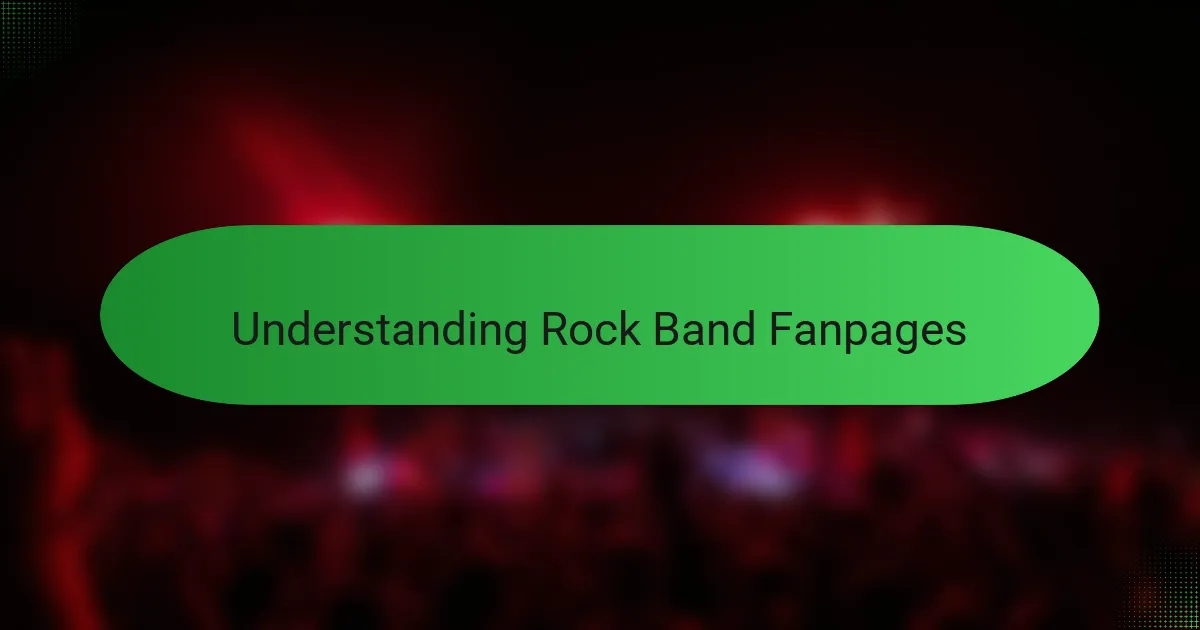
Understanding rock band fanpages
When I first started exploring rock band fanpages, I quickly realized they are more than just collections of photos and news—they’re communities pulsing with passion. Have you ever found yourself scrolling through a page and felt that raw energy from fellow fans? That’s the magic of these spaces: they create a sense of belonging and shared excitement.
From my experience, understanding what makes a fanpage resonate is about grasping its role as a hub for both information and emotion. It’s where fans celebrate milestones, debate lyrics, and relive concert memories together. Why do some fanpages feel warm and inviting, while others feel distant? It’s the careful balance of authentic content and interactive engagement that makes all the difference.
For me, a fanpage is not just about showcasing a band’s work but capturing the spirit they inspire. It’s a digital shrine to the music, stories, and, most importantly, the people who love it—fans just like me. Sometimes I wonder: how often do we pause to appreciate the deep connection these pages facilitate between artist and audience?
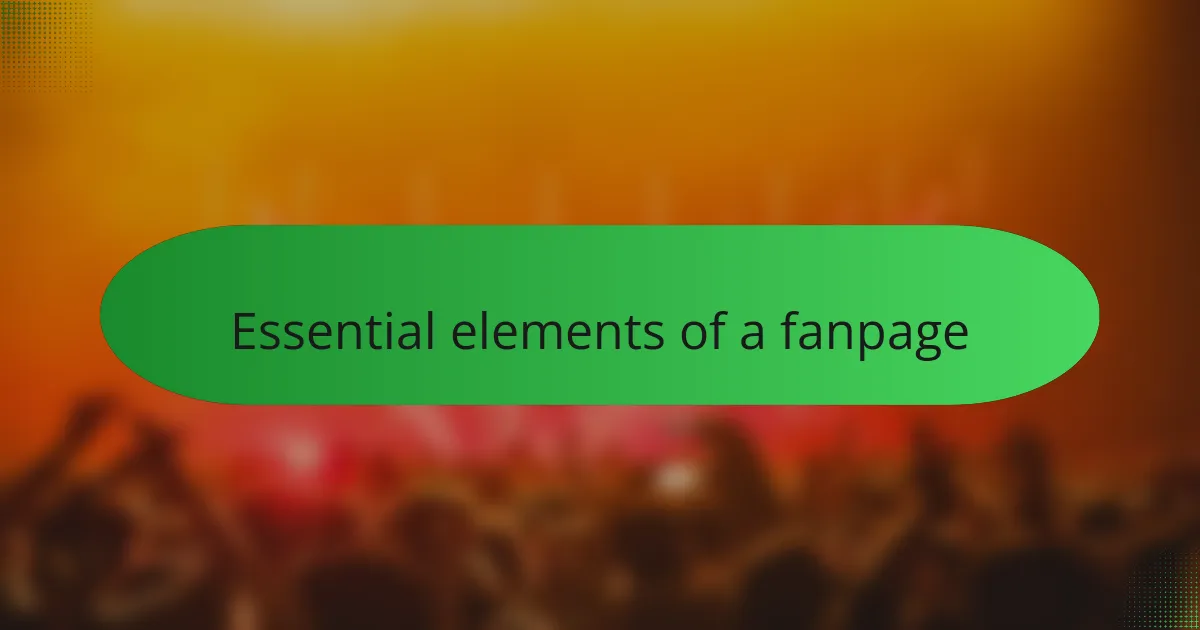
Essential elements of a fanpage
The first thing I knew my fanpage had to have was clear, vibrant visuals—band photos, album covers, and concert shots that instantly grab attention. Without that visual spark, how do you expect to pull in fans who are bombarded with endless content online? I remember redesigning my page after realizing dull images just weren’t doing justice to the band’s energy.
Next, I focused on curating timely and accurate information: tour dates, new releases, and behind-the-scenes tidbits. Fans crave this insider knowledge, but it has to be reliable. I often asked myself, would I trust this page as my go-to source? If the answer was no, I’d rethink what I shared.
Lastly, interaction proved essential. Polls, comment sections, and fan-submitted stories turned my fanpage into a lively hangout spot. I wanted visitors to feel part of something bigger, not just passive readers. Have you ever noticed how a simple “What’s your favorite album?” post can spark hours of passionate discussion? That’s the heartbeat of any thriving fan community.
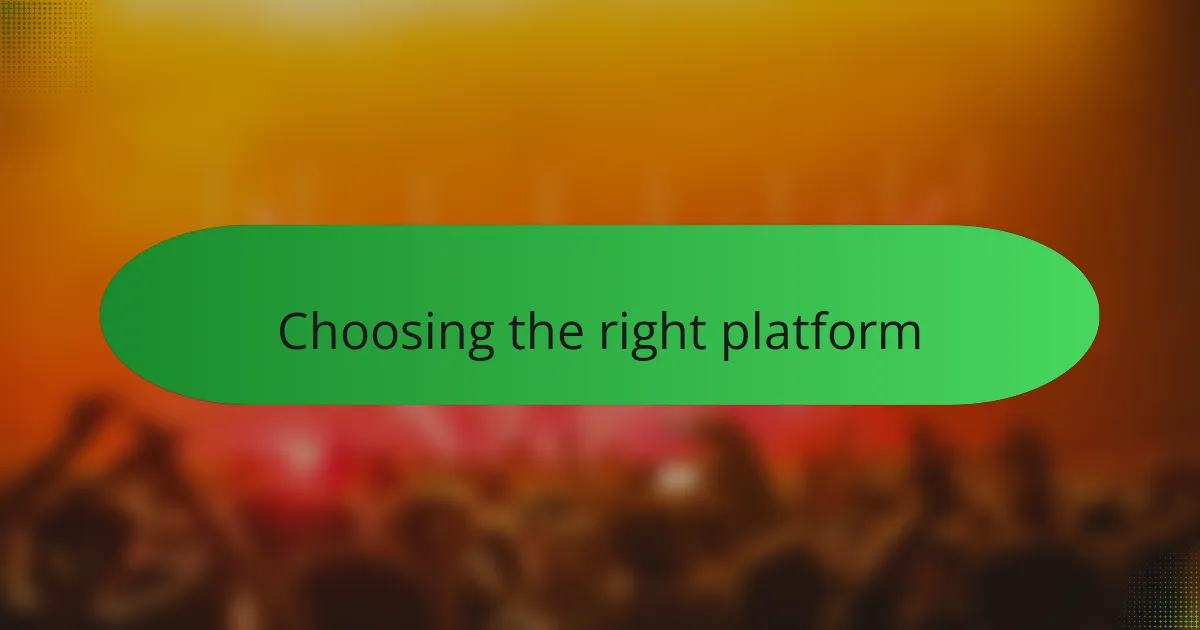
Choosing the right platform
Picking the right platform for my fanpage was like choosing the perfect stage for a concert—it had to feel just right for the vibe I wanted to create. I weighed options between all-in-one website builders and social media pages, asking myself: where would fans feel most at home? For me, flexibility and ease of customization won because I wanted to control every little detail.
I also thought about accessibility. Fans come from all over, with different devices and tech comfort levels. Does the platform load quickly? Is it mobile-friendly? These questions became my checklist. I learned that even the coolest design means nothing if fans struggle to navigate or interact with the page.
Finally, I considered the community features each platform offered. Would it support discussions, polls, and sharing fan content easily? From experience, knowing that fans could jump in and contribute without friction made all the difference. It transformed my fanpage from a static bulletin board into a buzzing gathering spot where everyone felt invited.
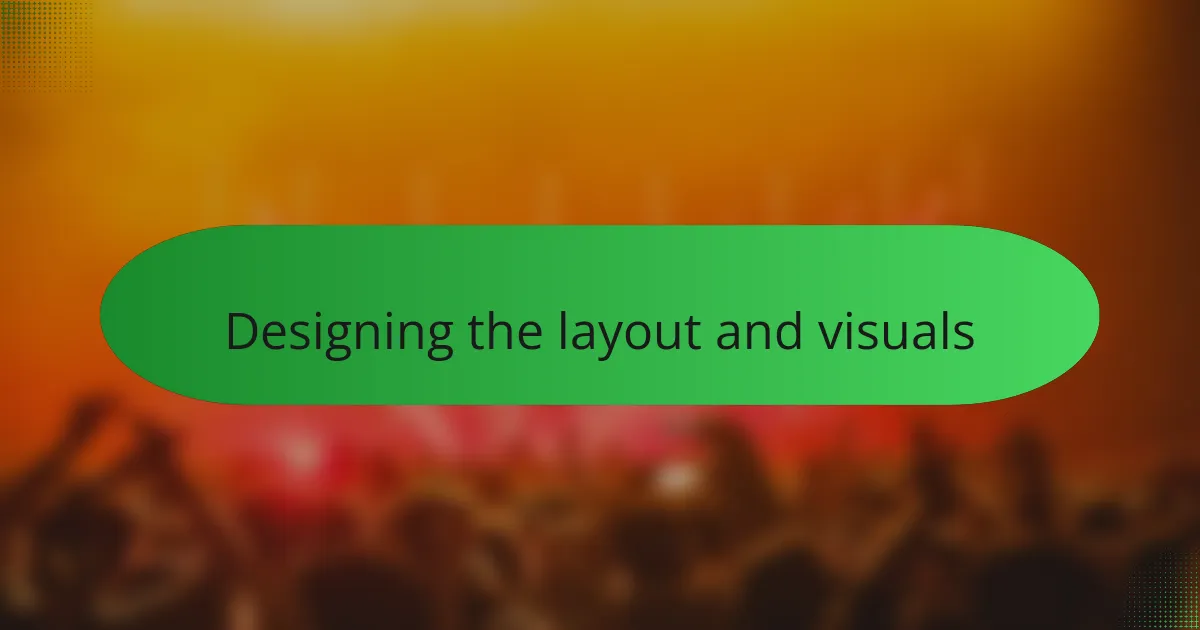
Designing the layout and visuals
When it came to designing the layout, I aimed for something that reflected the band’s raw, gritty attitude without overwhelming visitors. Striking a balance between bold colors and clean spaces was tricky, but I found that using dark backgrounds with vibrant accents created the right vibe—like stepping into an intimate concert venue rather than a cluttered info dump. Did I want fans to feel energized or lost in too much detail? That question guided every design choice.
Visuals were where I could really let the band’s personality shine. I incorporated high-quality images that captured moments of sweat, passion, and connection from their live shows. I remember spending hours selecting photos that told a story, not just pretty pictures. It made me think: isn’t that what a fanpage should do—evoke the experience, not just document it?
Navigation was just as important. I wanted fans to find what they were looking for without frustration, whether that was upcoming gigs, lyrics, or fan forums. Simple menus and clear section headers kept things intuitive. From my experience, thoughtful layout means fans stick around longer and come back often—something I saw firsthand as my page grew from a quiet note in the digital noise to a lively hangout spot.
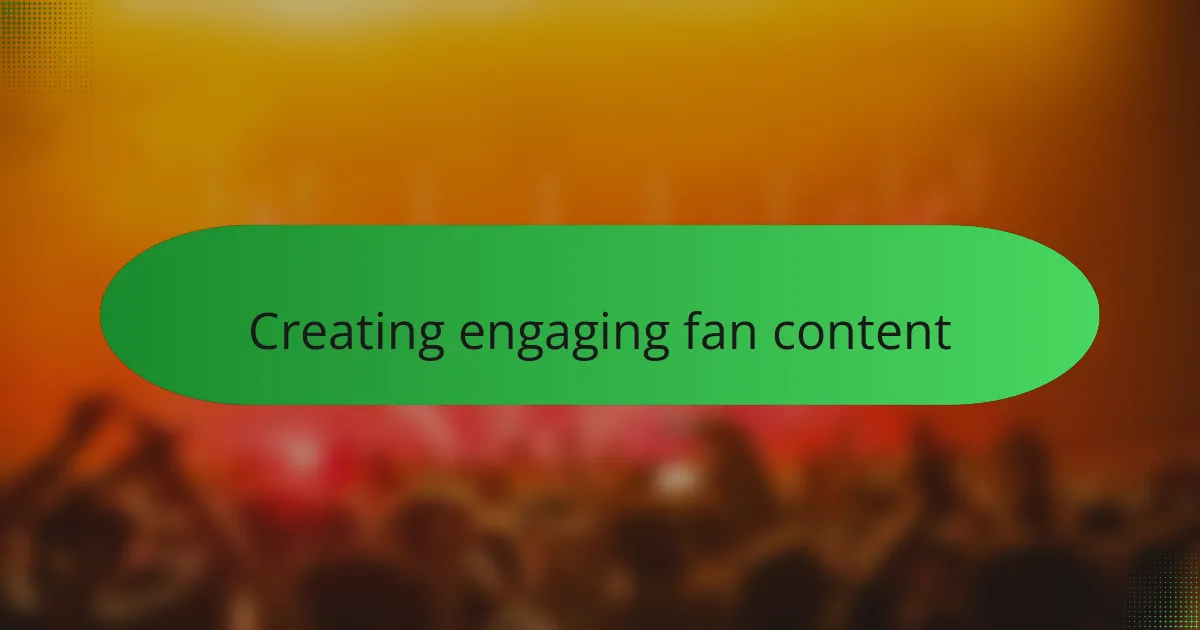
Creating engaging fan content
Creating engaging fan content was one of the toughest yet most rewarding parts of building my fanpage. I quickly learned that fans crave more than news—they want to feel heard and involved. So, I started by encouraging fans to share their own stories and concert experiences, which brought a fresh wave of authenticity to the page. Have you ever noticed how a fan’s personal story can light up an entire comment thread? That’s real engagement right there.
Another trick I found effective was mixing up the types of content. From quick polls asking about favorite guitar solos to deep dives into album meanings, variety kept things lively. I remember once posting a trivia quiz about the band’s early days, and the flood of responses not only boosted interaction but also sparked nostalgia and bonding among fans. It’s amazing how a simple question can turn a passive scroll into a lively conversation.
Creating content that resonates means paying attention to the little things—timing a post right after a new single drops, or sharing exclusive backstage photos when fans least expect it. It felt like finding a secret handshake with the community, a way to say, “I get you.” Do you think fans notice when content is made with genuine care? From what I see, they absolutely do, and that’s what keeps them coming back.
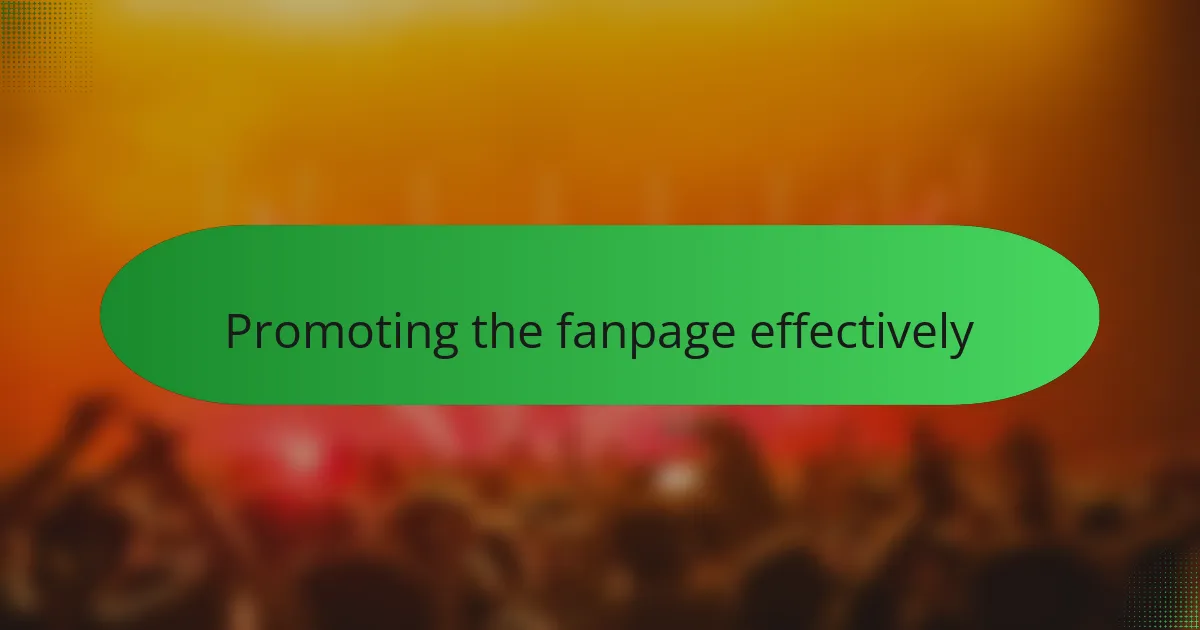
Promoting the fanpage effectively
Promoting the fanpage effectively meant I had to think beyond just posting updates. I realized that sharing content on platforms where rock fans naturally hang out—like music forums, social media groups, and even concert event pages—made a huge difference. Have you ever stumbled upon a fanpage because a friend tagged you or because it popped up in your favorite band’s discussion? That kind of organic reach felt far more powerful than just broadcasting links.
I also found that timing was crucial. Posting right after a concert, album release, or big announcement created a wave of excitement that carried my posts further. Sometimes, I’d schedule a series of teasers leading up to those moments, knowing fans were hungry for new info and ready to engage. It’s like catching the right beat—miss it, and the moment’s gone, but get it just right, and the energy’s electric.
Lastly, engaging with fans personally became my secret weapon. Responding to comments, sharing fan art, or giving shoutouts made people feel valued. I’ve noticed that when fans know there’s a real person behind the page who listens and cares, they don’t just visit once—they come back and bring their friends. Doesn’t that kind of connection feel like the core of any real fan community? From my experience, that authentic interaction turns a simple page into a thriving fan hub.
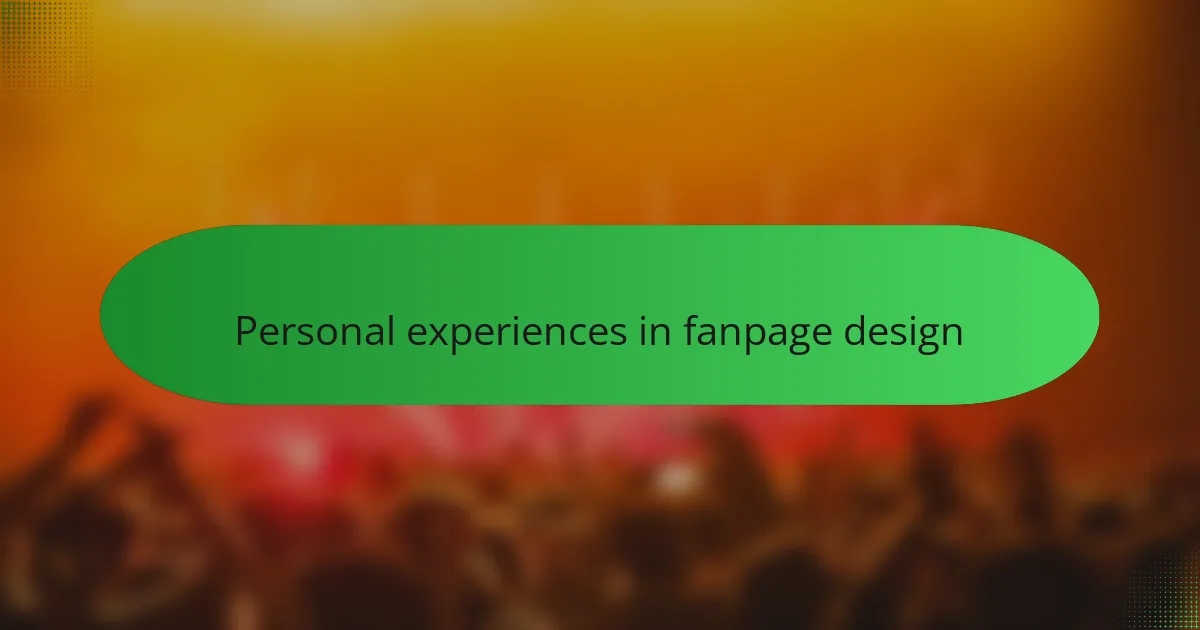
Personal experiences in fanpage design
Designing my rock band fanpage was a journey filled with trial and error. I remember the first time I tried to organize content—I thought cramming everything onto one page would make it easier, but fans found it overwhelming. It taught me that simplicity and clear structure aren’t just design buzzwords; they genuinely affect how fans experience the page.
One challenge I didn’t anticipate was capturing the band’s energy visually while keeping the page user-friendly. Balancing bold colors with readable fonts felt like walking a tightrope. Did I get it right on the first try? Absolutely not. Each adjustment brought a better feel, and those small wins made me realize how much design is about listening to the fans as much as the band.
Engagement also surprised me. I wasn’t sure if fans would jump into discussion threads or share their stories, but once they did, it changed the whole vibe of the page. There’s something powerful about seeing fans connect over shared memories and passions—it reminded me why I started the fanpage in the first place. Have you ever experienced that spark where a simple comment turns into a meaningful conversation? For me, that’s fanpage gold.